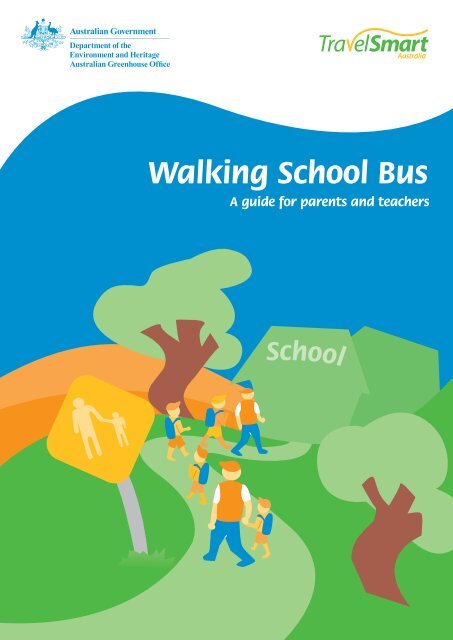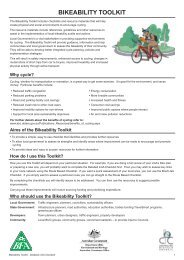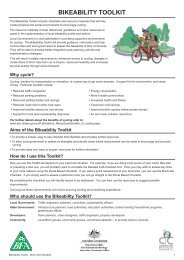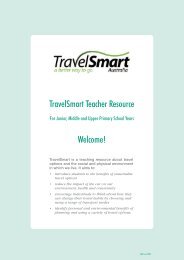Walking School Bus - A Guide for Parents and Teachers
Walking School Bus - A Guide for Parents and Teachers
Walking School Bus - A Guide for Parents and Teachers
Create successful ePaper yourself
Turn your PDF publications into a flip-book with our unique Google optimized e-Paper software.
WALKING SCHOOL BUS <strong>Guide</strong> <strong>for</strong> <strong>School</strong> Communities <strong>and</strong> <strong>Parents</strong><br />
Welcome to the <strong>Walking</strong> <strong>School</strong> <strong>Bus</strong> <strong>Guide</strong> prepared <strong>for</strong> school communities<br />
throughout Australia. This guide explains the <strong>Walking</strong> <strong>School</strong> <strong>Bus</strong> concept<br />
to parents of primary school aged children, <strong>and</strong> provides in<strong>for</strong>mation about how<br />
to join, or how to set up a <strong>Walking</strong> <strong>School</strong> <strong>Bus</strong> program in your school.<br />
In some local areas, states or territories, there are guidelines <strong>and</strong> resources<br />
on how to run a <strong>Walking</strong> <strong>School</strong> <strong>Bus</strong>. Contact in<strong>for</strong>mation is listed in this guide<br />
<strong>and</strong> on the TravelSmart Australia website.<br />
http://www.travelsmart.gov.au/schools<br />
What is a WALKING SCHOOL BUS<br />
A <strong>Walking</strong> <strong>School</strong> <strong>Bus</strong> is a group of primary school children who walk to <strong>and</strong><br />
from school along a safe <strong>and</strong> enjoyable set route, accompanied by a minimum of<br />
two parent driver/supervisors per ‘bus’. One parent ‘drives’ at the front of the bus,<br />
while the other parent supervises at the rear. Additional parents may be needed<br />
depending on the local requirements. The walking bus picks up ‘passengers’ along<br />
the way at designated ‘bus stops’.<br />
The ‘bus stops’ can be meeting points along the route or at homes of the <strong>Walking</strong><br />
<strong>School</strong> <strong>Bus</strong> participants. The process is reversed in the afternoon, led by the<br />
same or a different adult driver/supervisor. It can be fl exible to suit the needs of<br />
families using it. The ‘bus’ can go as seldom or as often as parents want to ‘drive’<br />
it <strong>and</strong> children want to use it. This means that it can even operate as little as one<br />
morning or afternoon each week. Many schools start the <strong>Walking</strong> <strong>School</strong> <strong>Bus</strong> on<br />
a one-day per week basis <strong>and</strong> increase its schedule over time. The service is free.<br />
Every child is welcome to join the bus even if their parents cannot be drivers.
BENEFITS of the <strong>Walking</strong> <strong>School</strong> <strong>Bus</strong><br />
Many school communities have started their own walking bus programs, which<br />
support increasing needs to change our travel choices. Each child who is part of a<br />
<strong>Walking</strong> <strong>School</strong> <strong>Bus</strong> is potentially one less vehicle on the road. This eases traffic<br />
congestion, increases safety <strong>and</strong> reduces pollution.<br />
The benefi ts of the <strong>Walking</strong> <strong>School</strong> <strong>Bus</strong><br />
reach the whole community <strong>and</strong> include:<br />
• a safe <strong>and</strong> convenient way <strong>for</strong> children<br />
to travel to school;<br />
• improvement of health <strong>and</strong> well being<br />
through walking <strong>and</strong> talking;<br />
• an opportunity <strong>for</strong> children to learn road<br />
sense <strong>and</strong> traffic safety;<br />
• reduction of traffic congestion around schools;<br />
• contributing to a sustainable environment;<br />
• opportunities <strong>for</strong> children <strong>and</strong> parents to<br />
develop friendships <strong>and</strong> a sense of place<br />
<strong>and</strong> community in their neighbourhood.<br />
<strong>Walking</strong> <strong>School</strong> <strong>Bus</strong> parents’ views:<br />
“From our experience of the <strong>Walking</strong> <strong>Bus</strong> it has only been a positive thing. It gets all<br />
of us walking more <strong>and</strong> the children do not complain about walking like they used to”.<br />
“Socially, it’s great because the children meet other children they otherwise would<br />
only know by sight. My children have <strong>for</strong>med some good friendships because of the<br />
<strong>Walking</strong> <strong>Bus</strong>. The parents get to know other parents too!”<br />
“<strong>Parents</strong> no longer have to get their children to <strong>and</strong> from school everyday.<br />
On days when I’m not rostered on I get an extra hour or so at the end<br />
of the day to myself. On days when the weather is too bad to walk,<br />
we are still better off because we usually car pool with other<br />
families on the <strong>Walking</strong> <strong>Bus</strong>”.<br />
<br />
Page 2
HOW TO JOIN a <strong>Walking</strong> <strong>School</strong> <strong>Bus</strong><br />
You may have a <strong>Walking</strong> <strong>Bus</strong> Coordinator or a TravelSmart <strong>School</strong> Coordinator<br />
in your local area who can advise you on routes <strong>and</strong> how to join a <strong>Walking</strong><br />
<strong>School</strong> <strong>Bus</strong> Program.Contact your school Parent Association or local council to<br />
find out. You can also find out about <strong>Walking</strong> <strong>School</strong> <strong>Bus</strong> Programs in your state<br />
or territory through the contacts listed in this guide.<br />
HOW TO START a <strong>Walking</strong> <strong>School</strong> <strong>Bus</strong><br />
If you live in an area where there are no <strong>Walking</strong> <strong>School</strong> <strong>Bus</strong> programs in place,<br />
you may like to start one. <strong>Walking</strong> <strong>School</strong> <strong>Bus</strong> initiatives are voluntary <strong>and</strong> can<br />
be championed by parents, teachers, schools, local councils, or any interested<br />
community groups.<br />
The main ingredients <strong>for</strong> success are people with commitment <strong>and</strong> enthusiasm to<br />
involve others <strong>and</strong> get the bus moving.<br />
The Hobart City Council <strong>and</strong> Tasmanian Environment Centre have together created<br />
a <strong>Walking</strong> <strong>School</strong> <strong>Bus</strong> video <strong>and</strong> an online guide, which can be used as an<br />
example of a program <strong>and</strong> a guide <strong>for</strong> Parent Associations.<br />
The following steps may ensure the walking bus is organised safely <strong>and</strong> effectively.<br />
Please note that in order to run a <strong>Walking</strong> <strong>School</strong> <strong>Bus</strong>, some states have<br />
minimum st<strong>and</strong>ards which need to be met which include police checks, volunteer<br />
insurance, audit of routes by traffic engineers <strong>and</strong> training <strong>for</strong> volunteers.<br />
The Steps Involved<br />
• Form a <strong>Walking</strong> <strong>School</strong> <strong>Bus</strong> Working Group comprising members from<br />
your school Parent Association, parents, students, the school principal <strong>and</strong><br />
teachers. Be aware the role of the school <strong>and</strong> Parent Association may vary<br />
between states <strong>and</strong> territories subject to duty of care <strong>and</strong> legal liability<br />
issues. For example, in some states the only role that a Parent<br />
Association may have is to support <strong>and</strong> promote the<br />
<strong>Walking</strong> <strong>School</strong> <strong>Bus</strong> as part of a program of your state<br />
or territory’s Transport Department, Planning Department,<br />
Education Department or other government authority.<br />
<br />
Page 3
• Invite your relevant <strong>Walking</strong> <strong>School</strong> <strong>Bus</strong> contact to give a presentation on<br />
the concept of the <strong>Walking</strong> <strong>School</strong> <strong>Bus</strong>. To find the relevant contact, get in<br />
touch with your local Council, state TravelSmart program or your state or<br />
territory’s Transport Department.<br />
• The relevant contact will provide (or your group can develop) a parent survey<br />
<strong>for</strong>m <strong>for</strong> your school to distribute with the regular school newsletter.<br />
Survey responses are directed to a nominated school community member to<br />
find out if there is any interest in a <strong>Walking</strong> <strong>School</strong> <strong>Bus</strong> Program <strong>and</strong> to<br />
help in planning the routes. You could ask your local Council <strong>for</strong> a map of<br />
the area <strong>and</strong> attach it to the survey <strong>for</strong> parents to mark where students live.<br />
This in<strong>for</strong>mation will help to plot the best route possible. A sample of a parent<br />
survey <strong>for</strong>m is provided by TravelSmart WA in this in<strong>for</strong>mation pack <strong>and</strong> is<br />
online at http://www.travelsmart.gov.au/schools/pubs/parentsurvey.doc<br />
• Your <strong>School</strong> Community<br />
Volunteer (or relevant<br />
contact) will collect the<br />
in<strong>for</strong>mation <strong>and</strong> report the<br />
survey results to the school<br />
Parent Association.<br />
Once a route has been<br />
decided, volunteers should<br />
walk the path to make sure<br />
it is going to work. Ask your<br />
local council engineering<br />
department to survey the<br />
chosen route <strong>for</strong> safety issues.<br />
• The responsibility <strong>for</strong> providing public liability cover varies from state to<br />
state, there<strong>for</strong>e, ask your <strong>School</strong> Principal, TravelSmart officer or Local<br />
Government contact whose responsibility this is <strong>and</strong> how to proceed<br />
in order to secure the cover.<br />
<br />
Page 4
• The recruitment of volunteer parent driver/supervisors will be organised by<br />
your <strong>School</strong> Community Volunteer (or <strong>Walking</strong> <strong>School</strong> <strong>Bus</strong> contact) <strong>and</strong><br />
school Parent Association. Give volunteers an idea of what is expected <strong>and</strong><br />
how much time it is likely to take. It useful to prepare a Volunteer In<strong>for</strong>mation<br />
Kit to include in<strong>for</strong>mation about volunteers’ responsibilities, procedures <strong>for</strong><br />
dealing with incidents <strong>and</strong> a roster sheet <strong>and</strong> contact cards <strong>for</strong> drivers/<br />
supervisors <strong>and</strong> participants. In most states <strong>and</strong> territories, <strong>Walking</strong> <strong>School</strong><br />
<strong>Bus</strong> volunteers require police clearance. Check with your relevant contact<br />
to find out whether this is a requirement <strong>and</strong> whether there is an opportunity<br />
to negotiate a reduced rate <strong>for</strong> multiple checks in order to reduce the cost.<br />
Volunteer insurance varies from state to state; you will need to contact your<br />
local government or another organisation (e.g. community health) to find out<br />
how to arrange this in your state so that your volunteers are insured from the<br />
very beginning.<br />
• Arrange <strong>for</strong> your <strong>Walking</strong> <strong>School</strong> <strong>Bus</strong> contact to run training sessions<br />
with volunteer parent driver/supervisors in risk management <strong>and</strong> safety.<br />
Once the ‘buses’ get moving, the <strong>School</strong> Community Volunteer will liaise<br />
with the school <strong>and</strong> participating parents to support <strong>and</strong> promote the<br />
<strong>Walking</strong> <strong>School</strong> <strong>Bus</strong>. You could create a pledge, which applies the<br />
school’s rules <strong>and</strong> values, <strong>for</strong> children to sign regarding the expected<br />
behaviour from all participants.<br />
• <strong>Parents</strong> have the responsibility <strong>for</strong> the ongoing management of the<br />
<strong>Walking</strong> <strong>School</strong> <strong>Bus</strong> Program. Your Working Group will elect a volunteer<br />
coordinating parent to oversee the daily organisation of the <strong>Walking</strong> <strong>School</strong><br />
<strong>Bus</strong>. This may involve responding to any problems or concerns that occur<br />
on the morning or afternoon ‘bus’ run, such as changes in driver/supervisor<br />
availability or an issue that has arisen along the ‘bus’ route. Drivers/<br />
supervisors are usually required to carry a mobile phone to immediately<br />
report any concerns. You may want to create an Emergency Response Plan<br />
<strong>for</strong> all volunteers to familiarise with. This plan could include in<strong>for</strong>mation<br />
about children with medical conditions <strong>and</strong> what to do in an<br />
emergency.<br />
• Sample roster sheets, certificates <strong>and</strong> contact cards are<br />
provided in this in<strong>for</strong>mation pack <strong>and</strong> are available<br />
online at http://www.travelsmart.gov.au/schools<br />
<br />
Page 5
How can you PROMOTE the <strong>Walking</strong> <strong>School</strong> <strong>Bus</strong><br />
• Make the first <strong>Walking</strong> <strong>School</strong> <strong>Bus</strong> trip a significant event by organising<br />
a launch date <strong>and</strong> announce it to the local community through press releases<br />
to the media <strong>and</strong> planned photo opportunities. Involve your school principal<br />
<strong>and</strong> consider inviting community leaders to speak or participate at the launch.<br />
• <strong>Parents</strong> <strong>and</strong> the school community can help to promote the <strong>Walking</strong> <strong>School</strong><br />
<strong>Bus</strong> Program by liaising with the <strong>School</strong> Community Volunteer (or your<br />
relevant contact), <strong>and</strong> by using all the communication networks that already<br />
exist in the school. Promote the <strong>Walking</strong> <strong>School</strong> <strong>Bus</strong> routes around the<br />
school <strong>and</strong> provide a list of contacts.<br />
• Use school assemblies <strong>and</strong> other events <strong>for</strong> raising the profile of the ‘buses’<br />
by telling good news stories about estimated distances walked over a period<br />
of time, <strong>and</strong> estimated greenhouse gas emissions saved.<br />
• Feature stories <strong>and</strong> regular advertising in the school newsletter are essential.<br />
• Encourage enthusiasm by running competitions through the school <strong>for</strong><br />
students to name their ‘bus’ or even design ‘bus’ mascots. Creating artworks<br />
or mascots will provide great photo opportunities to promote the <strong>Walking</strong><br />
<strong>School</strong> <strong>Bus</strong> in your local newspaper.<br />
• Reward those that make the ‘bus’ great.<br />
• Remember that it is essential to consult <strong>and</strong> involve your school principal in<br />
any publicity strategy that you might be planning.<br />
Acknowledgements<br />
This guide has been prepared by the Australian Greenhouse Office in the<br />
Department of the Environment <strong>and</strong> Heritage with concepts provided through:<br />
the <strong>Walking</strong> <strong>School</strong> <strong>Bus</strong> Program, CLIENT: Planning NSW <strong>and</strong> Kogarah Council<br />
CONSULTANT: People <strong>for</strong> Places <strong>and</strong> Spaces, Sydney; the <strong>Walking</strong> <strong>School</strong><br />
<strong>Bus</strong> Brochure, <strong>and</strong> Program, Department <strong>for</strong> Planning <strong>and</strong> Infrastructure, WA; <strong>and</strong><br />
VicHealth <strong>Walking</strong> <strong>School</strong> <strong>Bus</strong> Program.<br />
<br />
Page 6
Further In<strong>for</strong>mation:<br />
Travelsmart Australia<br />
Australian Greenhouse Office<br />
Department of Environment <strong>and</strong> Heritage<br />
GPO Box 787<br />
Canberra ACT 2601<br />
Ph: AGO Infoline 1300 130 606<br />
http://www.travelsmart.gov.au<br />
Australian Capital Territory – TravelSmart <strong>School</strong>s <strong>Walking</strong> <strong>School</strong> <strong>Bus</strong><br />
YWCA of Canberra<br />
GPO Box 767<br />
Canberra ACT 2601<br />
Ph: 02 6239 6878<br />
http://www.ywca-canberra.org.au/walking_school_bus.htm<br />
Northern Territory<br />
Department of Infrastructure, Planning <strong>and</strong> Environment<br />
GPO Box 2520<br />
Darwin NT 0801<br />
Ph: 08 8924 7531<br />
Queensl<strong>and</strong> – <strong>Walking</strong> <strong>School</strong> <strong>Bus</strong><br />
TravelSmart QLD<br />
PO Box 673<br />
Fortitude Valley QLD 4006<br />
Ph: 07 3253 4006<br />
http://www.transport.qld.gov.au/travelsmart<br />
South Australia – TravelSmart to <strong>School</strong><br />
TravelSmart SA<br />
PO Box 1<br />
Walkerville SA 5081<br />
Ph: 08 8226 8222<br />
http://www.transport.sa.gov.au/environment/travelsmartsa<br />
<br />
Page 7
Victoria – <strong>Walking</strong> <strong>School</strong> <strong>Bus</strong><br />
VicHealth<br />
PO Box 154<br />
Carlton South VIC 3053<br />
Ph: 03 9667 1353<br />
http://www.vichealth.vic.gov.au<br />
http://www.vichealth.vic.gov.au/rhadmin/articles/files/<strong>Walking</strong><strong>School</strong><strong>Bus</strong>.pdf<br />
Tasmania – Move Well Eat Well <strong>for</strong> <strong>School</strong><br />
Department of Education<br />
<strong>School</strong> Education Division<br />
GPO Box 919<br />
Hobart TAS 7001<br />
Ph: 03 6233 7811<br />
Tasmanian Environment Centre<br />
102 Bathurst Street<br />
Hobart TAS 7000<br />
Ph: 03 6234 5566|<br />
http://www.tasmanianenvironmentcentre.org.au/<br />
http://www.tasmanianenvironmentcentre.org.au/projects/documents/<br />
<strong>Walking</strong><strong>Bus</strong>-<strong>Guide</strong>14.7.04final.pdf<br />
Tasmania – <strong>Walking</strong> <strong>School</strong> <strong>Bus</strong> Program<br />
& <strong>Walking</strong> <strong>School</strong> <strong>Bus</strong> <strong>Guide</strong><br />
Hobart City Council<br />
GPO Box 503<br />
Hobart TAS 7001<br />
Ph: 03 6238 2711<br />
http://www.hobartcity.com.au/<br />
Western Australia – <strong>Walking</strong> <strong>School</strong> <strong>Bus</strong><br />
TravelSmart WA<br />
GPO Box C102<br />
Perth WA 6839<br />
Ph: 08 9216 8306<br />
http://www.dpi.wa.gov.au/travelsmart/schools.html<br />
http://www.dpi.wa.gov.au/travelsmart/publications/<br />
walkingschoolbus.html<br />
<br />
Page 8<br />
Published by the Australian Greenhouse Office in the Department<br />
of the Environment <strong>and</strong> Heritage<br />
© Commonwealth of Australia 2005.<br />
ISBN: 1 920840 05 2






